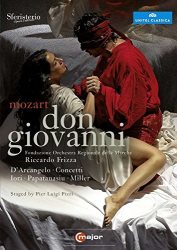| 
|
Wolfgang Amadeus MOZART (1756-1791)
Don Giovanni - Dramma giocoso in two acts, K527 (1787)
Don Giovanni - Ildebrando D'Arcangelo (bass-baritone); Leporello - Andrea Concetti (bass-baritone); Don Ottavio - Marlin Miller (tenor); Masetto - William Corro (baritone); Anna - Myrto Papatanasiu (soprano); Elvira - Carmela Remigio (soprano); Zerlina - Manuela Bisceglie (soprano); Commendatore - Enrico Iori (bass)
Fondazione Orchestra Regionale Delle Marche/Riccardo Frizza
rec. live, Teatro Lauro Rossi, Macerata, Italy, Sferisterio Festival, 2009
Stage Director, Sets and Costumes: Pier Luigi Pizzi
Video Director: Davide Mancini
Picture Format: 16:9, NTSC from an HD source
Sound formats: DTS 5.0, PCM Stereo
Subtitles: Italian (original language), English, German, French, Spanish, Chinese, Korean, Japanese
Booklet notes: English, German, French
C MAJOR DVD 717408 [2 DVDs: 174:00]
By 1785 Mozart had moved from Salzburg to Vienna via Munich. He did this to enlarge his opportunities as by then his strengths as an opera composer were widely recognised and the genre was to remain central to his ambitions. In 1786 he commenced collaboration with court poet Lorenzo Da Ponte to realise the immensely popular Le Nozze di Figaro with its taut plot and integrated music. The work was immediately widely acclaimed and was produced in Prague with unprecedented success. Bondi commissioned a new opera for production the following autumn. Mozart returned to Vienna and sought the cooperation of Da Ponte for the provision of a suitable libretto. Although Da Ponte was working on librettos for two other composers he agreed to Mozart's proposal.
Don Giovanni was well received in Prague. However, for a production in Vienna the following year there were problems. The tenor couldn’t sing his Act 2 aria Il Mio Tesoro and Mozart substituted the aria Dalla sua pace, better suited to his abilities - here heard at No.10 in Act 1 (DVD 1. Ch.27). The role of Elvira was to be sung in Vienna by a protégée of Salieri who demanded a scena for herself. Mozart added the accompanied recitative In quali eccessi and the aria Mi tradi at No.26 (DVD 2. Ch.26). Common performance practice and recorded custom is to incorporate the Vienna additions into the Prague original. This approach is followed here. However, perhaps as a result of the origins of the libretto, added to the insertions of the Vienna scenes, a performance can sometimes seem a hotch-potch with dramatic cohesion compromised. The production and set needs to be capable of quick change from one often-short scene to the next, whilst the producer must accommodate the intimate with the more public group situations.
The mise-en-scène of this production places the work in the period of its composition. The sets move swiftly and easily with the additional help of an opening back-stage and a space below the steeply raked main stage. These often combine swiftly to accommodate the various scenes. The major prop is a bed, scene of seductions and other sexual activity. Veteran director, Pier Luigi Pizzi sees sex as the focus of the opera, not unreasonable if Don Giovanni had achieved one thousand and three seductions in Spain alone, as Leporello claims in his serenade to Elvira, whilst taking advantage of the bed and her as he does so (DVD 1. Ch.12). The bed is also handy for man-to-man frolics between master and servant, certainly something Da Ponte did not imagine (DVD 1.Ch.28./ DVD 2. Chs.1-2). Later, Elvira, in low-cut nightdress, just, writhes during Mi tradi (DVD 2.Ch.17) with her vital statistics all but making an unscheduled appearance; cheap titillation in the small Teatro Lauro Rossi? As to Zerlina’s balm for Masetto’s bruises, sustained as a result of being dusted up by Giovanni, well, I need not amplify further than to note she strips off his shirt and then his trousers before utilising the voluminous skirt of her opulent dress, for a supposed peasant girl, to good effect.
The singing and acting is good throughout, the former aided by the cast not having to strain in a theatre of a thousand or more. Marlin Miller as Ottavio is less of a wimp than usual but has to reach somewhat for his high notes. Myrto Papatanasiu’s Anna is good with Carmela Remigio’s Elvira even better, as singers and actresses. As Zerlina, Manuela Bisceglie has an appealing stage presence and a well-supported lyric voice. Masetto, her intended sung by William Corro, has vocal appeal, his baritone contrasting with the deeper tones of the eponymous role and that of his servant. Andrea Concetti as Leporello and Ildebrando D'Arcangelo as the Don are very similar in vocal tone. This is useful when they exchange clothes, each taking the role of the other. That said, it is the suave and brilliant all-round characterisation of Ildebrando D'Arcangelo which dominates his rather plainer partner. Lithe of figure and moving like a born stage animal, he dominates the proceedings when present. His singing is, on occasion not as mellifluous as some famous predecessors, but pretty good all the same. How far any limitation is caused by Riccardo Frizza’s sometimes-rushed tempi is debatable. Certainly his conducting does not erase memories of one or two more natural Mozarteans of yesteryear in this work.
Whilst Pier Luigi Pizzi’s staging brings clarity, it fails badly in the penultimate scene where Don Giovanni goes down to hell (DVD 2.Ch.29). In this performance he rolls down the raked stage onto the lower level where naked members of the underworld, of both sexes, greet him. It lacks some atmosphere, which might have been helped by red lighting. As it is, Hell with naked ladies might seem the wrong place for Don Giovanni and his predilections.
The concluding credits and applause include views of the delightful and small Teatro Lauro Rossi.
Robert J Farr
 |
 |
|
